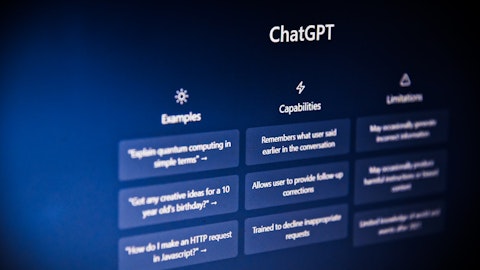Baidu, Inc. (NASDAQ:BIDU) Q2 2023 Earnings Call Transcript August 22, 2023
Operator: Hello and thank you for standing by for Baidu’s Second Quarter 2023 Earnings Conference Call. At this time, all participants are in a listen-only mode. After management’s prepared remarks, there will be a question-and-answer session. Today’s conference is being recorded. If you have any objections you may disconnect at this time. I would now like to turn the meeting over to host for today’s conference, Juan Lin, Baidu’s, Director of Investor Relations.
Juan Lin: Hello, everyone, and welcome to Baidu’s second quarter 2023 earnings conference call. Baidu’s earnings release was distributed earlier today and you can find a copy on our website, as well as on newswire services. On the call today, we have Robin Li, our Co-Founder and CEO; Rong Luo, our CFO; Dou Shen, our EVP, in charge of Baidu, AI, cloud Group, ACG; Zhenyu Li, our SVP, in-charge of Baidu’s Intelligent Driving. After our prepared remarks, we will hold a Q&A session. Please note that the discussion today will contain forward-looking statements made under the Safe-Harbor provisions of the U.S. Private Securities Litigation Reform Act of 1995. Forward-looking statements are subject to risks and uncertainties that may cause actual results to differ materially from our current expectations for detailed discussions of these risks and uncertainties, please refer to our latest Annual Report and other documents filed with the SEC and Hong-Kong Stock Exchange.

alphaspirit/Shutterstock.com
Baidu, does not undertake any obligation to update any forward-looking statements except as required under applicable law. Our earnings press release and this call includes discussions of certain unaudited non-GAAP financial measures. Our press release contains a reconciliation of the unaudited non-GAAP measures to the unaudited most directly comparable GAAP measures and is available on our IR website at ir.baidu.com. As a reminder, this conference is being recorded. In addition, a webcast of this conference call will be available on Baidu’s IR website. I will now turn the call over to our CEO, Robin.
Robin Li: Hello, everyone. I’m pleased with our financial performance in the second quarter. Revenue from online marketing increased by 15% year-over-year, reflecting improvement in advertiser segment. In Q2, non-GAAP operating profit for mobile ecosystem continued to strengthen and AI cloud, once again, delivered positive operating profit. At the same time, we are facing tremendous opportunities in foundation models or more broadly AGI. Today, I would like to share an update on our ongoing business transformation by utilizing ERNIE and ERNIE Bot as well as our achievements in the field. After that, I’ll briefly go over the operational highlights for each of our business. Over the past few months, foundation models have captured the imagination of people and businesses around the world.
It is becoming increasingly clear that foundation models will fundamentally transform work across the industry, boosting overall productivity and accelerate the wider democratization of AI innovation. Right now, we are in the midst of the rolling period. This is due to the fact that the hard work we poured into generative AI over the years is now beginning to bear fruit. This pivotal and transformative opportunity is setting the stage for Baidu’s future success and we couldn’t be more excited about it. On product and service front, we’re using ERNIE and ERNIE Bot to improve, review and create new offerings. On the product side, we are reinventing our products building AI native apps. Providing search, AI has played an important role for many years in driving innovation and improving user experience, resulting in a consistent increase in the percentage of third quarter satisfied by one-shot search results.
It means the first search results displayed on the result page that can provide a satisfactory response to a search query. We’re using ERNIE Bot to enhance search experience, making Baidu search capable of answering complex questions that were previously unanswerable. For example, please prompt a marketing campaign proposal for a smartphone launch event, or what kind of new energy vehicles would be suitable for a family six with a budget of RMB300,000. ERNIE Bot also enables Baidu’s search to assist users with more personalized and in-depth research on a topic or project. The feedback from users who have tested these new features has been positive. Another example of product innovation is Baidu Wenku, where many users search for articles, papers, books or campaigns to create documents of wide range of topics in many formats.
We’re currently beta testing an AI assistant feature that can generate a customized content for users based on their request. User engagement and retention among Baidu Wenku’s testing users for such feature solve significant improvement. For example, users have doubled their time spent on Wenku after trying out the AI assistant feature, and they are more likely to become paying users. Currently, Wenku has over 100 million monthly active users, and we believe such an intelligent feature will help Wenku attract even more users and convert non-paying users to paying users once it is rolled-out on a larger scale. Generative AI offers right horizons for our online marketing business and we are actively using the technology to build and review our marketing products.
Actually, our online marketing business has relied on AI for years to provide more value to advertisers. Last quarter, we shared on our progress on using the AIGC to automate ad creation in text format, which lead to an increase in conversion rate. This quarter, we further enable advertisers to use AIGC to generate image and video app with natural language. In Q2, we further improved our monetization system by yielding generative AI to broaden ad campaign keyword to user search queries, driving better monetization for advertisers. For example, an online professional education company’s ad conversion increased by about 16% in August after using these new features. We are consistently enhancing our system are using generative AI and we expect to introduce more and more new features in the coming months.
Additionally, we have been leveraging generative AI to enhance our auction system, so that it can better match ads to search queries and search intent. Such improvement help increase Baidu search ECPM in Q2 and contributed to the year-over-year growth in online marketing revenue in the quarter. We are also in active conversations with advertisers to get their input on how to further make our marketing products work best for them. Meanwhile, we will continue to leverage ERNIE and ERNIE Bot to help advertisers create sophisticated ad campaigns and improve ROI on Baidu. One other initiative, I’d like to mention here is that, internally, we introduced an AI assistant within inflow Baidu’s self-developed enterprise communication and collaboration platform.
The AI assistant automates various workflows such as summarizing meeting notes, chat history and workplace content, drafting documents, generating draft, facilitating knowledge Q&A and completing tasks such as creating meetings invite, applying for vacation days and conducting data analysis using natural language. This assistance helps our employees work more productively. We plan to open up the intelligent features of info flow to our customers in the future. Alongside our own products, we are empowering cloud customers to build their transformative products and services using ERNIE Bot. In Q2, the number of corporates connecting to ERNIE Bot continue to grow. Foundation models, large language models and generative AI are expanding our total addressable market, attracting new customers while also increasing sales to our existing customers.
We are also using ERNIE and ERNIE Bot to help customers in various industries, address real-world challenges with unprecedented effectively and competence. This further strengthens the capabilities of ERNIE and ERNIE Bot, empowering them to take on more significant role in solving industry-specific issues. For example, in the software development industry, we launched Baidu Comet, an AI coding assistant to the public in June. By the Comet eight people in coding and can be used in multiple programming languages. It has now been widely adopted Baidu’s own R&D team. Who have reported a meaningful improvement in their productivity after using Comet. As of today, more than 100 organizations have tested by the Comet, and some of them have already decided to purchase Baidu Comet to boost productivity and coding.
In the health care industry, we are solidifying our presence by utilizing industry expertise and sales network developed through our collaboration with leading hospitals in China. Chongqing limited a traditional Chinese medicine clinic chain is using our early based model, developed for the health care industry to support doctors and their patient care. Our AI assistant helps doctors write notes for patients analyze medical images and make informed clinical decisions among other tasks. It also helps patients find the most suitable doctor and department and provide pre-consultation service online. Furthermore, we’ve developed tools for model training and fine-training, data processing, labeling and more. These tools help to lower the threshold and cost for enterprises to use foundation models on Baidu and support them to train and operate their purpose-built models efficiently.
Additionally, Baidu AI cloud stands out as our AI optimized cloud infrastructure makes us a top performing platform for training and serving foundation models, including large lending model. This is why more and more enterprises are upping their digital spend on our cloud infrastructure to capture the new AI opportunities. This is particularly obvious among Internet and tech companies as they are early adopters of Gen AI and foundation models. Shifting our focus to technology, as Baidu we maintained an unwavering commitment to improve earnings. During Q2, we unveiled earning 3.5. Our latest state-of-the-art foundation model powered by PaddlePaddle. Notably, PaddlePaddle enhancements enabled our self-device four-layer AI architecture to operate more seamlessly than ever before.
Significantly improve the frameworks compatibility with ERNIE and demonstrating engineering excellence. As a result, compared to ERNIE 3.0% in March, ERNIE 3.5 past triple training throughput and its quest per second or QPS for inference has increased by more than 30 times. Additionally, I’m proud to note that IDC recently reported that ERNIE 3.5 surpassed peers in many areas such as algorithm, industry coverage, developer tools and ecosystem. As compared to ERNIE 3.0, 3.5 is capable of producing safer, more responsible and more creative responses, making significant improvements in question answering, reasoning and coding. ERNIE 3.5 is now powering ERNIE Bot, with plugging to expand its functionality to cover real-time and precise information, long taxed summary, data analysis and virilization, text-to-video conversion and facilitate pilot dialogues that include images.
We are committed to enriching our ecosystem by adding more high-quality plugging in particular from third-parties to contribute to the advancement of China’s foundation model. On the ecosystem front, we are determined to make ERNIE the most popular foundation model in China. Importantly, we believe foundation models should be able to well support problem solving capabilities for various industries. As a result, we need to work collaboratively with our partners such as enterprises and AI developers to continually build industry models and solutions. Our 8 million developers on PaddlePaddle are the anchor that we can leverage to build a community for ERNIE. To foster a vibrant ecosystem, we hosted Baidu ERNIE Cup Innovation Challenge. It attracted almost 1,000 startups to submit their ideas and prototypes, covering various fields, encompassing productivity towards developers, sales and marketing companies, entertainment companies, social platform, middleware developers, as well as applications across different industries, including education, health care, finance, et cetera.
We have also launched a venture fund of RMB1 billion to support start-ups in divesting all kinds of AI native applications, which will complement our organic growth. On regulation, Baidu have recently up — Baidu was recently appointed as a leader of China’s LLM Standardization Task Force at the World AI Conference. This position signifies national-level recognition and endorsement of our foundation models and AI capabilities. While we are still waiting for the green light for large scale rollout of ERNIE Bot, we have observed that Chinese government have been increasingly supportive of the development opportunity of AI and LLM. As a market leader, we believe Baidu is well capable of benefiting from the opportunity and contributing to this megatrend in China.
Now let’s have a quick look of the second quarter operating highlights for each business. Revenue from AI Cloud increased by 5% year-over-year to RMB4.5 billion in the quarter. And AI Cloud maintained positive non-GAAP operating profit. Our business has become healthier than ever laying a solid foundation for future growth. On intelligent driving, in Q2, the rights provided by Apollo Goal increased by about 150% year-over-year to around 714,000, resulting in accumulated rights exceeding RMB3.3 million, which is greater than our closest competitor by order of magnitude. This leadership in operation implies competitive advantages in data quantity and quality, that better model and greater safety ratings. In addition, Apollo Go has widened footprint in fully driverless ride-hailing services in more settings.
In mid-June, Apollo Go received a permit from Shenzhen Pingshan government to offer 40 driverless ride-hailing services to the public. And in early July, in Shanghai, we were allowed to conduct fully driverless testing on open road as well. With the expansion of the area and fleet size for fully driverless operation along with the improvement of operational efficiency, we witnessed growth not only in the total average daily orders, but also in the portion of fully driverless orders within the overall order portfolio. This highlights a promising pathway for improving the unit economics of autonomous driving. In particular, in Wuhan, where we initiated fully driverless ride-hailing services one year ago, the UE continued to improve in the past few quarters.
On the revenue side, the average daily order volume and revenue per order have surged propelling total revenue to grow. Meanwhile, the cost per kilometer per car is decreasing as well, thanks to improved operational efficiency. Finally, our mobile ecosystem, our users continue to grow with Baidu Apps, MAUs increasing by 8% year-over-year to RMB677 million in June. Also in June, videos distributed by Baidu App achieved double-digit growth year-over-year. Baidu remained a significant platform for users, who are seeking a wide range of content such as information, products and services. The revenue growth rate for online marketing accelerated in Q2 aided by strengths in wireless verticals with offline exposure, including healthcare, business services, local services and travel.
At the same time, revenue from e-commerce demonstrated strength and outperformed in the quarter. Non-GAAP operating profit for mobile ecosystems grew steadily year-over-year in the quarter. Mobile ecosystem continued to generate robust cash flow to fund our investments in AI, particularly in foundation models and generated AI. We are confident that revenue, profit and cash flow generated from our mobile ecosystem will remain strong in the future. With that, let me turn the call over to Rong to go through our financial results.
Rong Luo: Thank you, Robin. Now let me walk us through the details of our second quarter financial results. Total revenue was RMB34.1 billion, increasing 15%, one-five year-over-year, revenue from Baidu Core was RMB26.4 billion, increasing 14%, one-four year-over-year. Baidu Core’s online marketing revenue was RMB19.6 billion, increasing 15%, one-five year-over-year. Baidu Core’s non-online marketing revenue was RMB6.8 billion, up 12% year-over-year. In Q2, AI cloud revenue increased by 5% year-over-year to RMB4.5 billion. Revenue for IT was RMB7.8 billion, increasing 17%, one-seven year-over-year. Cost of revenue was RMB16.2 billion, increasing 7% year-over-year. Baidu Core’s cost of revenue was RMB10.6 billion, increasing 4% year-over-year.
Operating expenses were RMB12.7 billion, increasing 14% one-four year-over-year, primarily due to an increase in channel spending promotional marketing expenses, server depreciation expenses and cloud-related expenses, which supports ERNIE Bot research improves and partially offset by a decrease in personnel-related expenses. Baidu cost operating expenses were RMB11.3 billion, increasing 15%, one-five year-over-year. Baidu Core SG&A expenses were RMB5.3 billion, increasing 34% year-over-year. SG&A accounting for 20% helps Baidu Core revenue in the quarter compared to 17%, one-seven same period last year. Baidu Core R&D expenses was RMB5.9 billion, increasing 2% year-over-year R&D, accounting for 23% of Baidu Core revenue in the quarter and decreased from 25% the same period last year.
Operating income was RMB5.2 billion, Baidu Core’s operating incomes RMB4.6 billion and Baidu Core’s operating margin was 17%, one-seven. Non-GAAP operating income was RMB7.3 billion, non-GAAP Baidu Core’s operating income was RMB6.5 billion and non-GAAP Baidu Core operating margin was 25%. Total other income net towards RMB1.4 billion compared to RMB151 million in the same-period last year, primarily due to the increase in net foreign exchange gain and net interest income, partially offset by the increase of fair value loss from long-term investments. The income tax expenses was RMB1.3 billion, compared to RMB25 million in the same period last year. The lower level for income tax expenses in the second quarter of 2022 is primarily due to the reversal of certain tax expenses based on the 2021 tax return.
Apart from the reversals, the net reason for the increase of income tax expenses is the increase in profit before-tax year-over-year. Net income attributable to Baidu was RMB5.2 billion and diluted earnings per ADS was RMB14.17. Net income attributable to Baidu Core was RMB5 billion and net margin for Baidu Core was 19%, one-nine. Non-GAAP net income attributable to Baidu was RMB8 billion, non-GAAP diluted earnings per ADS was RMB22.5. Non-GAAP net income attributable to Baidu Core was RMB7.7 billion. Non-GAAP net margin for Baidu Core was 29%. As of June 30, 2023, cash, cash equivalents, restricted cash and short-term investments were RMB201.5 billion in cash, cash equivalents, restricted cash and short-term investments excluding iQIYI, RMB196.9 billion.
Free cash flow was RMB7.9 billion and free cash flow excluding iQIYI was RMB7.1 billion. Baidu Core had approximately 35 solid employees as of June 30, 2023. With that, operator let’s now open the call to questions.
See also Long-Term Returns of Dan Loeb’s Activist Targets and 20 Countries with Fastest Internet Speeds.
Q&A Session
Follow Baidu Inc (NASDAQ:BIDU)
Follow Baidu Inc (NASDAQ:BIDU)
Operator: Thank you. We will now begin the question-and-answer session. [Operator Instructions] The first question today comes from Alicia Yap with Citigroup. Please go ahead.
Alicia Yap: Hi, thank you. Good evening, management, thanks for taking my questions. Congrats on the solid results. So can management provide update on the current state of the advertising industry, including how online and offline platforms are recovering? Can management also share about the pace of recovery for key industry and which one have stronger seasonality? And then in addition, can management also discuss the main drivers for the growth in this industry? And finally, what are the medium-term growth targets for at as we are now already behind the pandemic and with the current latest macro situation? Thank you.
Robin Li: Hi, Alicia, this is Robin. Let me answer your question. Our online marketing revenue increased by 15% year-over-year last quarter. I think a number of travelers contributed to this growth. On the vertical side as we are coming out of the pandemic, many offline verticals like healthcare, business services, local services and travel continue to outperform. For example, healthcare, we saw solid year-over-year growth in both search queries and ECPM, which leads to revenue trends. We think this momentum continue. Offline sector contributes to a sizable amount of total online marketing revenue to Baidu. And in the meantime, e-commerce continue to grow in Q2 and remain top revenue contributors. For market like e-commerce, it’s highly competitive.
So more and more merchants, they come to realize the value of Baidu, and they come to us to acquire new users and buyers and also invite their existing buyers to come back and buy more. For the second-half of the year, we should continue to see a pretty clear recovery trend for our online marketing business. Also remember, search remains the most effective form of performance-based ad. This is because users approach search with a clear intent and search ads allows us to connect this intention directly with the most relevant product service offerings. In fact, the ECPM for our search outgrow other ad formats in the quarter, reflecting the effectiveness. Due to the relatively high comp base in Q3, the growth rate might not be as high as Q2, but it should well outperform China’s GDP growth.
Additionally, we have more immersive video features. More and more users are watching the short videos on Baidu. Short videos distributed through the Baidu App, again grew by double-digit in Q2. As a result, revenue from short videos continue to grow quite well, contributing meaningfully to the overall online marketing revenue growth. Looking into the mid- to long term, I believe both user traffic growth and monetization upgrades are important growth drivers for our online marketing business. And on the user side, I talked about our MAU, it grew by 8% year-over-year in Baidu App growth rate in June — in the month of June. If we look at search, we are renovating the Baidu Search step-by-step using ERNIE Bot. We believe it will provide users with innovative and intuitive experience, which will help our mobile ecosystem gain traffic and increase user time spend.
And on the monetization side, we’ve been leveraging AI to improve ad targeting capabilities and our bidding system for a number of years. And now with ERNIE and ERNIE Bot, we are further upgrading the game. I mentioned earlier that we have made some major improvement in advertising technology by using LLM and Generative AI. Along for more innovative and personalized ads, I believe there are lots of room for growth in this aspect, and I look forward to further breakthroughs. Such improvement in monetization technology have started to contribute to revenue and ECPM growth starting from this quarter in Q3. Thank you.
Operator: The next question comes from Gary Yu with Morgan Stanley. Please go ahead.
Gary Yu: Hi, thank you for the opportunity to ask question and congrats on the solid set of results. I have a couple of questions related to AI product and monetization. First is, can management share some insight on how users have responded to the integration of ERNIE Bot in multiple products? Any new development of features that have come up with the ERNIE Bot offerings [Technical Difficulty] help with market growth in China Internet and specifically in the mobile Internet sector? And also, lastly, I would like to know more about the monetization [Technical Difficulty] we play a role in your advertising business? And also [Technical Difficulty] update in key industries and use cases related to B side. Can you provide additional information on the business model and also potential revenue specifically, I would like to gain a better understanding on financial impact on cloud performance.
Robin Li: Hi, Gary, let me answer the consumer-facing products part of your question, and I’ll have Dou talk about the enterprise side, especially cloud business. I think it’s clear we are in a paradigm shift in our business with our early commitment to AI, we saw this time coming. We are reinventing our consumer-facing products with an AI-native mindset. As I mentioned in my opening remarks, we are rebuilding our search experience. Users who are testing our ERNIE Bot enabled Baidu search and Baidu app tend to ask more questions that were not frequently searched in the past and we tend to have multi-round conversation and interaction. This is quite different from the user behavior for traditional search. Therefore, it’s an incremental business for us.
We are using generative AI to construct direct answers to user queries. This typically creates better and easier to understand answers than experts from existing web pages. We see increases in click-through rate and user retention rate for these kind of changes. We also launched the testing version of ERNIE Bot App, a step along app that is built upon our latest generative AI and LLM. And it aims to serve users as a personal assistant. We see ERNIE Bot a potential new traffic gateway that can connect users to various applications, including Baidu and other third-party applications, to address users’ needs. We also launched ERNIE Bot plug-ins like search, like chat [Indiscernible] e-card, et cetera. Developers will soon be able to submit their application as ERNIE Bot plug-in.
For Baidu Core is the AI assistant feature on average user time spend more than doubled and the seven-day retention rate has increased by almost 10%. With the AI assistant, I will not be surprised that we can convert more users into paying accounts and charge-off premium for the new AI function in the future. Overall, we are highly encouraged by user feedback. This is just the beginning for us to reconstruct all the products and businesses with LLM and Generative AI. Very importantly, we have also saying promising opportunities to lift the monetization capability by rebuilding our advertising system. As I mentioned in the prepared remarks, ERNIE and ERNIE Bot allow us to continue improving our targeting and a bidding system. All in all, I believe that generative AI will help us gain market share of many products and ultimately become a new growth driver for our online marketing business.
Dou Shen: Gary, for your second part, right? So for the impact on our cloud business, I would first mention that the beauty of the foundation model and Generative AI is that it can help organizations in many industry to increase productivity and efficiency. We see more and more enterprises willing to adopt such latest AI technologies and that’s why we will say the new technology is increasing our time. Specifically, ERNIE and ERNIE Bot has been helping our customers from different industries to handle their business challenges more effectively, ranging from like software, Internet health care, education, brand finance and even to the public sector. So they used ERNIE and ERNIE Bot to train models, to build applications and to improve solutions for efficiency gains, such as improving their customer service producing different kinds of content, ready coat, providing knowledge searches within their organizations as well as increasing their sales and marketing efforts.





